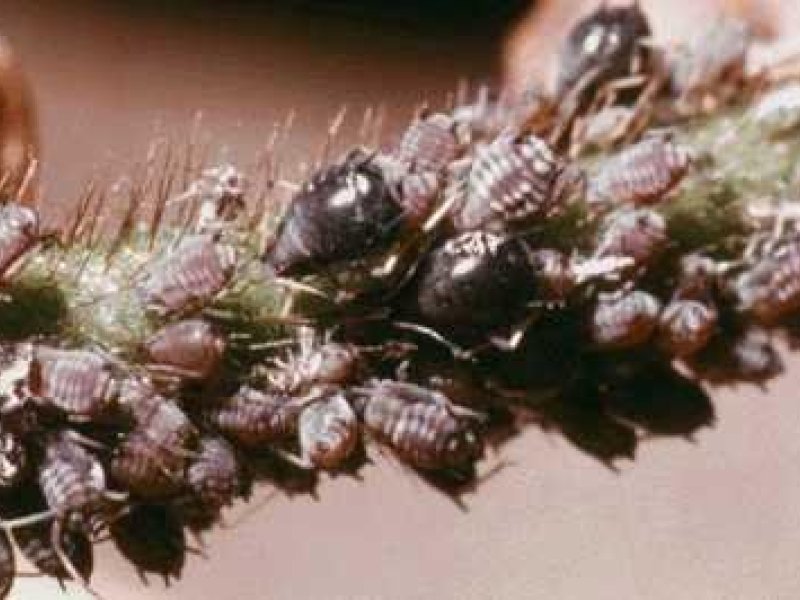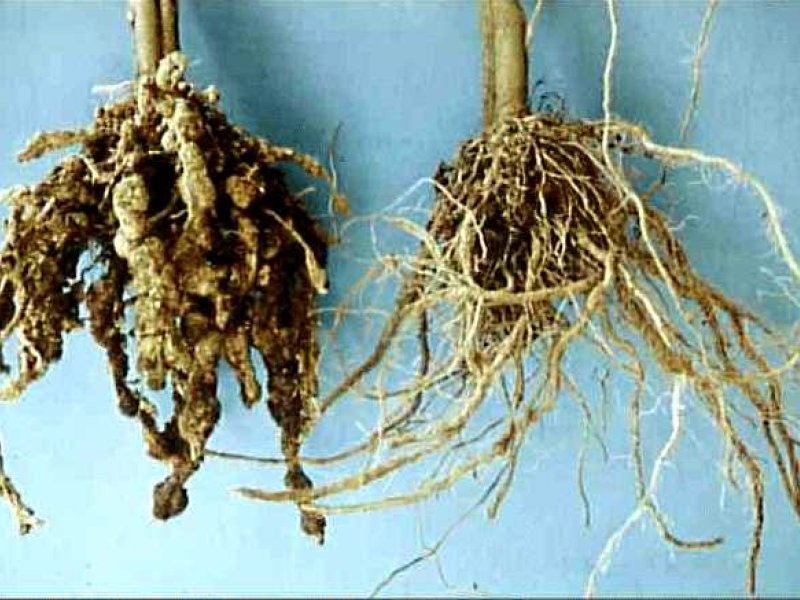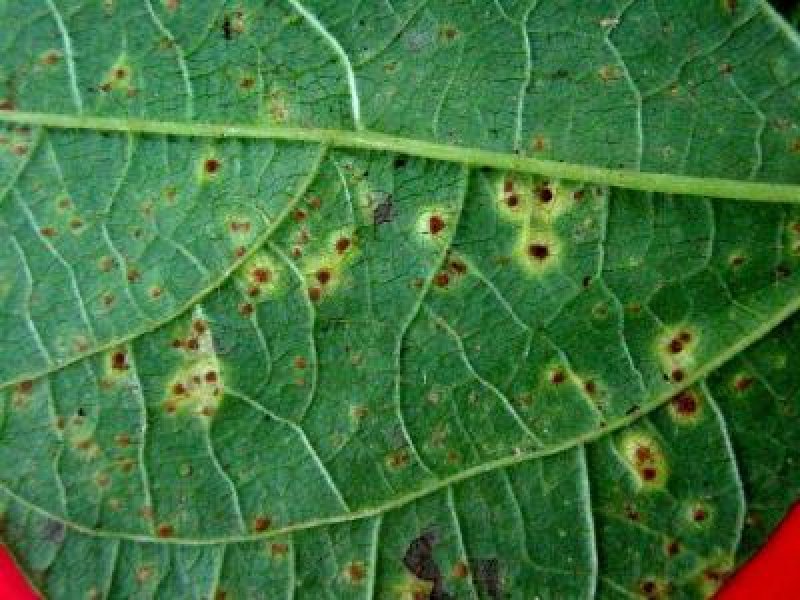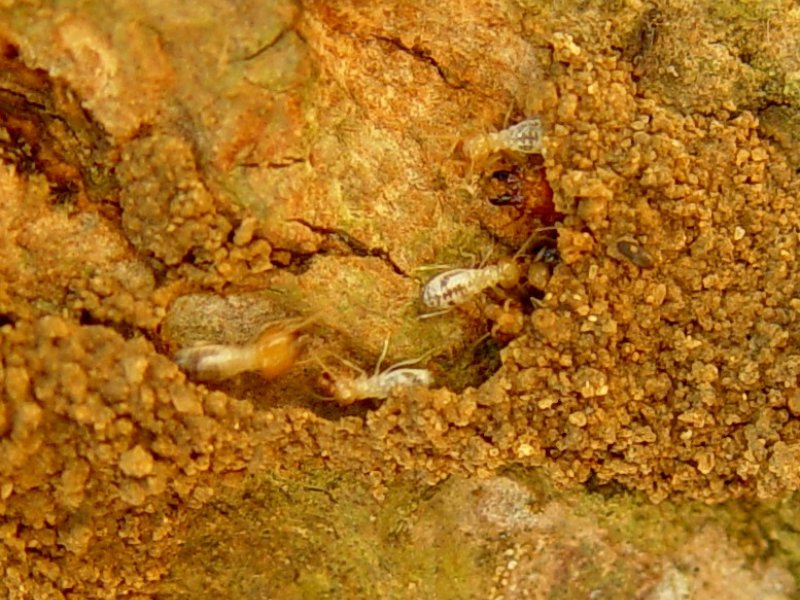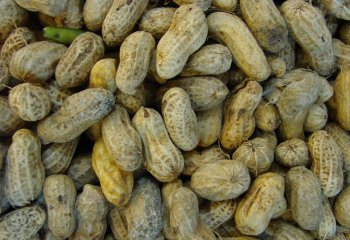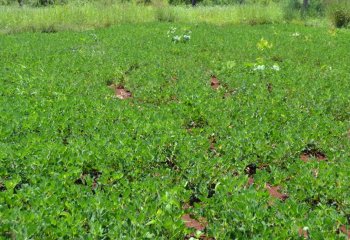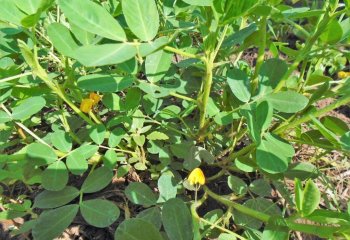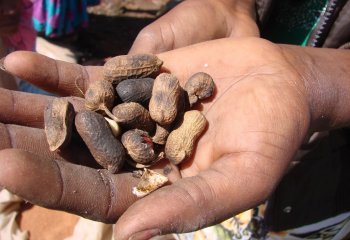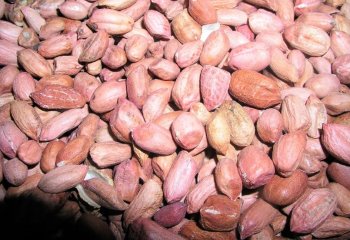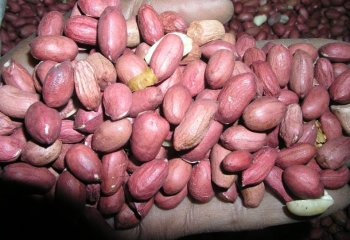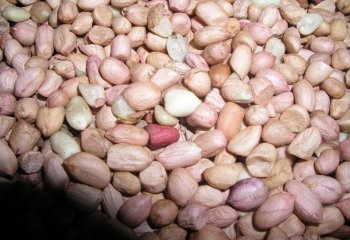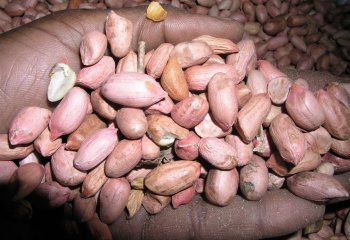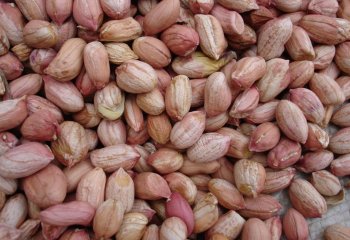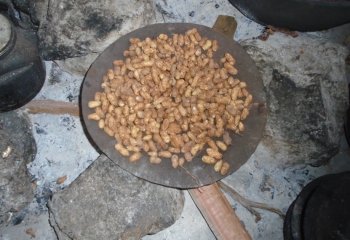|
Aphids (Aphis craccivora) It is a serious pest as a vector of virus diseases, such as the rosette virus disease, a major constraint to groundnut production, particularly in the dry season. The groundnut aphid is black or dark brown in colour, variable in size (1.5 to 2.0 mm long) with two black cornicles (horns at the rear of the body), and a black tail.
|
|
|
What to do:
|
|
Aspergillus crown rot (Aspergillus niger) The fungus causes both seed and seedling rot and drastically reduces plant stand. In moist soil, seeds may be attacked and killed due to rotting. Seeds removed from soil show black sooty cover. The infected areas of seedlings are covered with black fungal spores. Mature plants are also attacked. Symptoms include permanent wilt of branches, and or wilting of entire plant. The dead and dried branches are easily detached from the collar region. Infected pods reveal patches of black sooty spores. Related species (Aspergillus flavus) causes deterioration of seeds. It also produces the toxin (aflatoxin) in infected seeds that can cause death or other symptoms of toxicity when eaten by animals or humans. A. flavus as a mould contaminant and toxin producer is much less serious during growth of the crop than during subsequent storage of kernels. Minimising moisture stress during growth can reduce invasion and toxin production by A. flavus.
|
|
|
What to do:
|
|
Bacterial wilt (Ralstonia solanacearum) It can cause serious losses, if a crop is infected early. Infected plants show water stress symptoms and may wilt suddenly without yellowing of the foliage, particularly, when temperatures are high.
|
|
|
What to do:
|
|
Damping-off diseases (iPythium spp., Rhizoctonia solani) Damping-off diseases affect the initial establishment of a crop. Their main features include poor emergence and death of seedlings leading to poor stands in seedbeds and fields. Seeds may rot before germination. Affected seedlings that have emerged from the soil show water-soaking, browning and shrivelling of the stem at the soil level. They eventually fall over and die. Damping-off diseases are favoured by excessive wetness of the soil and low soil temperatures. |
|
|
What to do:
|
|
Aspergillus crown rot (Aspergillus niger) Aspergillus niger The fungus causes both seed and seedling rot and drastically reduces plant stand. In moist soil, seeds may be attacked and killed due to rotting. Seeds removed from soil show black sooty cover. The infected areas of seedlings are covered with black fungal spores. Mature plants are also attacked. Symptoms include wilt of branches permanently, and or wilting of entire plant. The dead and dried branches are easily detached from the collar region. Infected pods reveal patches of black sooty spores. Related species (Aspergillus flavus) causes deterioration of seeds. It also produces the toxin (aflatoxin) in infected seeds that can cause death or other symptoms of toxicity when eaten by animals or humans. A. flavus as a mould contaminant and toxin producer is much less serious during growth of the crop than during subsequent storage of kernels. Minimising moisture stress during growth can reduce invasion and toxin production by A. flavus.
|
|
|
What to do:
|
|
Groundnut hopper (Hilda patruelis) It is about 5mm in length, brown or green in colour with white marks and strips on the wings. The nymphs resemble the adults but without fully developed wings. These insects live in clusters or colonies, and are attended by ants that feed the honeydew excreted by the hoppers. These sucking insects attack the plants at the base of the stem, usually below ground level. The toxic saliva injected while feeding causes the plant to wither, turn yellow and die. The extent of damage can be important when the insect occurs in large numbers. The first sign of infestation is the presence of black ants.
|
|
|
What to do:
|
|
Groundnut rosette disease It consists of three types namely groundnut chlorotic rosette, groundnut green rosette and groundnut mosaic.
The disease is caused by a complex of different strains of groundnut rosette umbravirus. Symptoms vary depending on strain(s) present. They include yellowing, mottling and mosaic symptoms on leaves and stunting and distortion of the shoots. Older leaves are dark green, reduced in size, and show downward rolling of leaflet margins. If the plants are infected when they are young, they may not produce nuts.
The virus is transmitted by aphids (Aphis craccivora and A. gossypii), which feed on the undersides of the leaves.
|
|
|
What to do:
|
|
Leaf spots (Cercospora spp.) Symptoms of early leaf spot (Mycosphaerella arachidis, Cercospora arachidicola) consist of sub-circular dark brown spots produced on the upper leaflet surface. The spots are of lighter shade of brown on the lower side of the leaflets. Yellow halo is seen around the brown spots. Oval to elongate spots are also seen on stems, petioles, and pegs. Late leaf spot can be distinguished from those of early leaf spot.
Late leaf spots (M. berkeleyi, Cercosporidium personatum) are darker with no or light yellow halo. The late leaf spots on the lower leaflet surface are rough in appearance. They exhibit circular rings of fungus fruiting structures on the lower leaflet surface. Severe disease attack leads to shedding of leaflets resulting in premature ageing of the crop. Oval to elongate spots similar to early leaf spot are also formed on stems and pegs. Late leaf spot attack is usually seen along with rust disease.
|
|
|
What to do:
|
|
Groundnut leafminer (Aproaerema modicella) It is a common pest of groundnuts in South and South-East Asia and a major pest in India, and it has recently invaded Africa. It was first found in Uganda in 1998 and is now recorded in Mozambique, Malawi, Democratic Republic of Congo and South Africa. In all African countries where this leafminer has been found, the pest has reached epidemic densities and severe yield losses have been observed on groundnut (The New Vision. 2004; Kenis and Cugala, 2006). The adult is a mottled moth, with a full wing span of up to 18mm. The moth lays eggs on the underside of the groundnut leaf and petioles. Yellowish green caterpillars hatch, tunnel into the leaves and feed between the upper and lower epidermis of the leaf. Mined leaves become distorted within a few days. Caterpillars are grey-green with a shiny black head. There are five larval instars. The first instar has an average length of 0.56 mm. At pupation, they rarely exceed 8 mm in length. Three or four mines per groundnut leaflet can cause so much distortion that a leaf exposes as little as 30% of the potential photosynthetic area to the sun. Later, when the caterpillar becomes too large to occupy the mine, they emerge to the leaf surface and either fold over a single leaf and hold it down with silk, or web together two or more leaflets. They live and feed in the shelter they have constructed. Pupation takes place inside the webbed leaflets. Damaged leaves become brownish, rolled and dry, which results in early defoliation and affects the growth and yield of the plants.
|
|
|
What to do:
|
|
Millipedes (Peridontopyge spp.) Millipedes are among the economically important soil pest of groundnuts. They are brown to blackish in colour and curl when disturbed. They attack groundnut seedlings, between planting and approximately 20 days after planting, feeding on the emerging cotyledons and moving to the root system at the collar region. The cortex is often damaged serving as an entry point for secondary infection by microorganisms. The development of plants surviving the attack is often retarded. Millipedes also attack maturing groundnut during pod formation, i.e. when the pods are still soft. Immature pods from severed pegs are often perforated and thus suffer secondary infection or invasion by rot-causing organisms such as Aspergillus flavus. Millipedes may also damage flowers. Birds are main predators of millipedes.
|
|
|
What to do:
|
|
Root-knot nematodes They are widespread but their seriousness in yield reduction is unknown. They cause plant stunting, gall or knot formation on roots, and in severe cases wilting of affected plants
|
|
|
What to do:
|
|
Rust (Puccinia arachidis) Pustules (spots or blisters) can form on all aerial plant parts except flowers. Orange coloured pustules first appear on the lower surface of leaflets. Later, pustules may appear on the upper surface of the leaflets. The pustules on the stem are elongate and elevated. The pustules when mature rupture to release masses of reddish-brown spores, which blown by wind, spread the disease from plant to plant and far away to other groundnut fields.
|
|
|
What to do:
|
|
Spider mites (Tetranychus spp.) Spider mites may become serious pests of eggplant during the dry season. Attacked leaves show a stippled appearance (white specks), and their surface covered with a fine web. Continuous infestation causes the leaves to dry-up. The plants are stunted and yields reduced.
|
|
|
What to do:
|
|
Storage pests: moths and beetles Stored groundnuts are attacked by moths (Ephestia cautella, Plodia interpunctella, Cadra cautella), and beetles (Caryedon serratus, Tribolium castaneum, Trogoderma granarium). The larvae of moths and the grubs and adult beetles bore into and damage seeds. Moths cause extensive webbing. The bruchid beetle Caryedon serratus is the major pest of groundnut in pod shell in West Africa. A good post harvest pest management programme based on good storage practices is very important.
|
|
|
What to do:
|
|
Termites Termites are serious groundnut pests throughout the southern African region and West Africa. Species of Microtermes and Odontotermes are the most damaging, while Macrotermes cause occasional damage. The small-sized Microtermes spp., in particular, attack and invade growing groundnut plants through the roots and stem near ground level, hollowing them out and causing the plants to wilt and die with a consequent reduction in crop stand. Roots damaged by other soil pests, such as white grubs, are also prone to attack by termites. Some termite species (Macrotermes spp., Hodotermes mossambicus) cut off stem bases, and may cause 25-100% of plant losses. As the crop ripens the outer layers of the pods are scarified (removal of soft corky tissue between the veins of the pod) by termites allowing contamination of the seed with soil fungi, such as Aspergillus flavus, which produce lethal "aflatoxins". Scarification of pods is by far the most common type of termite damage at plant maturity, a factor often aggravated by late harvest. Scarification as high as 30% has been reported. Infested plants are not obviously diseased and are frequently harvested and contaminate the rest of the crop. Species such as Microtermes spp. also penetrate the pod to feed off the soft inner lining, filling the pod with soil. This form of attack leads to additional loss through premature germination of kernels. Stacks of plants left drying in the fields are also frequently attacked by species such as Odontotermes spp. with farmers losing between 30-40% of their crop at this stage. Termite damage is generally most serious towards the end of the growing season just prior to harvesting, and it is particularly serious during periods of drought (ARC/LRN. 2007).
|
|
|
What to do:
|
|
Thrips (Megalurothrips sjostedti and Frankliniella schultzei) Several species of thrips attack groundnuts. They have been reported as important pests of groundnuts in Uganda. The flower thrips (Frankliniella schultzei and Megalurothrips sjostedti) infest mainly buds and flowers. Attacked flowers are discoloured and scarred; terminal leaf buds are blackened and distorted after unfolding. Other species of thrips (e.g. Scirtothrips dorsalis and Caliothrips indicus) infest foliage. Thrips feeding causes yellowish-green patches on the upper leaf surface and brown necrotic areas and silvery sheen on the lower surface of the leaf; leaves become thickened and some curling occurs. In severe infestations, young leaves are severely deformed, plants are stunted and leaves are blighted.
|
|
|
What to do:
|
|
White grubs (Schyzonycha spp.) Whitegrubs are the larvae of scarab "chafer" beetles. They are white, C-shaped with a brown head and three pairs of legs. Many species of white grubs are associated with groundnut damage in parts of sub-Saharan Africa. The most important are Schyzonycha species. White grubs attack plants at all stages of growth. They eat roots and damage pods of groundnuts. White grubs feed mainly on the taproots and/or peripheral roots leading to stunting or death. They inflict cuts in the crown region of taproots; these lesions are often invaded by rot-causing fungi. White grubs also cut out pods from the base of groundnut pegs and destroy larger, soft pods. Plants are often attacked in a row. White grubs seem to prefer soils with sandy or loamy sand textures and are seldom observed in clay soils.
|
|
|
What to do:
|
Geographical Distribution in Africa
Geographical Distribution of Groundnut in Africa. Updated on 8th July 2019. Source FAOSTAT
© OpenStreetMap contributors, © OpenMapTiles, GBIF. https://www.gbif.org/species/5353770
Groundnuts originated in South America from southern Bolivia to north-western Argentina. The Portuguese apparently took them from Brazil to West Africa and then to south-western India in the 16th century. Africa is now regarded as a secondary center of diversity. Groundnuts are now grown in most tropical, subtropical and temperate countries between 40deg N and 40deg S latitude, especially in Africa, Asia, North and South America (Nwokolo, E, 1996).
General Information and Agronomic AspectsIntroduction
rachis hypogaea, commonly known as the peanut or groundnut, belongs to the family Fabaceae and the genus Arachis. The genus Arachis comprises about 70-80 species. A. hypogaea is the most economically significant species in the genus. Other species like Arachis villosulicarpa and Arachis stenosperma have also been grown for their seeds.
A. hypogaea is believed to have originated in South America, particularly in the regions that now encompass Brazil, Bolivia, and Paraguay. Today, peanuts are widely cultivated in various regions, including North and South America, Africa, Asia, and Australia mainly for their edible seeds. Peanuts are well-adapted to a range of environments, thriving in warm temperatures with fertile, light-textured, sandy, well-drained soils. They are often grown as annual plants, as they complete their life cycle in a single growing season.
© Maundu P, 2015
Peanuts are an essential food source for many cultures around the world. The seeds or kernels are consumed in various forms, including roasted, boiled, and ground into peanut butter. Additionally, peanuts are made into confectionery and snack foods, and are used as an ingredient for soups or made into sauces to use on meat and rice dishes. Peanuts are highly nutritious and provide a good balance of essential nutrients. The seeds are rich in oil (38-50%), protein, dietary fiber, vitamins (such as niacin, folate, and vitamin E), and minerals (including magnesium, phosphorus, and potassium). Groundnuts have also considerable medicinal value. They are reported to be useful in the treatment of disease such as haemophilia, stomatitis, and diarrhea.
Ⓒ Maundu P, 2015
© Maundu 2005
Beyond food consumption, peanuts are also crushed for oil that has both culinary and industrial applications. The press cake from oil extraction is feed rich in protein and is also used to produce groundnut flour, which is used in many human foods. Peanut shells are used for animal feed, and the residual meal after oil extraction can be used for livestock feed. The plant's ability to fix nitrogen makes it an important rotational crop in sustainable agricultural systems.
The global peanut market is substantial, with China, India, and the United States being among the key commercial producers. In Africa, countries such as Nigeria, Senegal, and Sudan are major peanut producers, contributing significantly to the continent's agricultural economy.
(Ntare, B.R., 2007, Plantvillage (n.d.), Carvalho, P. A et al., 2020, Nwokolo, E, 1996).
Species account
Arachis hypogaea is an annual plant with erect or prostrate stems up to 70cm long. Leaves: 4-foliolate with obovate to elliptic leaflets, arranged in alternate. Flowers: axillary, solitary on stalks, yellow, orange, cream, or white flowers which produce 'pegs', characteristic floral structures which sink into the ground to grow the pod. Fruits: pod 3-7 cm long with one to five seeds that develops underground.
The plant can reach 0.6 m in height depending on the variety and as an annual plant, survives only one growing season.
(Plantvillage (n.d.), Hyde, M.A., et al., 2023).
Ⓒ Maundu P, 2015
Ⓒ P Maundu, 2015
Ⓒ Foods of the Nairobi people, 2005
Groundnuts varieties
All the varieties of groundnut can be divided into two main subcategories namely;
Bunch variety These varieties are erect or bunch type with light green foliage, Pods are produced in clusters. Seeds are round, plump and light rose in color. Varieties are early maturing (90 to 100 days) and high yielding and almost free from dormancy with a high germination percentage (90-95). Varieties are small, tastier and a highly marketable variety.
Examples of this variety are Ah.32, Junagadh-II, GAUG-1, Kadiri-71.1, TMV-2, pol.1. pol.2, AK.12-24, Kopergoan-3 etc.
Spreading (Runner type) varieties completely trail along the surface of soil. Plants have dark green foliage. Seeds are oblong and dormant. Long duration (110-120 days), late maturity120 to 150 days (require a longer growing season), high yielding ability and have dormancy (60-75%), low germination per cent (85-90). Some examples of spreading varieties are Punjab-I, Ah.334, GAUG-2, TMV-3, Karad 4-11, M-145, M-13 etc.
(TIMEIS. (n.d.), ICAR (https://kvk.icar.gov.in/API/Content/PPupload/k0447_28.pdf)
Across Africa, groundnuts exhibit a fascinating range of variations that reflect their diverse origins and breeding endeavors. Peanuts can vary in size from small and bite-sized or plump and oval, with colors spanning from creamy white to deep red. Their flavors vary too, from buttery and mellow to robust and nutty. Different regions have bestowed them with local names, often rooted in the distinct qualities of the plants. These names frequently highlight attributes like seed color and size.
Ⓒ Foods of the Nairobi people, 2005
Ⓒ Foods of the Nairobi people, 2001
Ⓒ Foods of the Nairobi people, 2005
© Maundu p., 2005
Table: Groundnut varieties and mean kernel yield
|
Variety |
Mean kernel yield Kg/ha |
|
"Red Valencia" |
1500 |
|
"Severe 116" (white) |
1250 |
|
"Texas Peanut" |
1360 |
|
"Bukene" |
1530 |
|
"Manipintar" |
2450 |
|
"Makulu Red" |
2720 |
|
"Altika" |
900 |
|
"Homa Bay" |
770 |
|
"Asirya Mwitunde" |
1300 |
Ecological conditions
Groundnuts are grown in the warm tropics and subtropics below 1500 m above sea level, and in temperate humid regions with sufficiently long warm summers. Optimum mean daily temperature to grow is 30degC and growth ceases at 15degC. Cool temperatures delay flowering. Groundnuts cannot stand frost. Between 500 and 600 mm of water reasonably well distributed through the growing season allows a good production. Nevertheless, groundnuts are a drought-tolerant species and can withstand severe lack of water, but yield is generally reduced. If harvesting conditions are wet, aflatoxins (severe poison produced by some fungi such as Aspergillus spp. may develop on the nuts. Aflatoxin contamination is a major hazard to human and animal health. When thee groundnuts are poorly dried and stored, they pick mold and dirt, which attracts a fungi, that releases aflotoxin chemicals that are dangerous to human health especially the liver.
Because pods develop underground and must be recovered at harvest, crumbly, well-drained soils are preferred, but plants grow and develop adequately on heavier clay soils. For optimum growth, soil pH should be in the range 5.5 to 6.5, though Bunch types tolerate more acid conditions (pH 4.5) and some cultivars grow well in alkaline soils up to pH 8.5.
Agronomic aspects
Groundnuts are typically grown from seeds, although it's also feasible to use cuttings for vegetative propagation. These seeds can either be grown in a nursery and then moved to the main area, or they can be directly sown in the main field. Since the seeds are delicate and easily damaged, careful handling is necessary. It's crucial to remember that seeds with splits or damage won't sprout, so top-quality seeds are essential. These seeds should have dried naturally, but if that's not an option, artificially conditioned seeds can be used. However, excessive heat during drying can harm their ability to germinae. Sun-dried seeds are also not recommended for good germination (TIMEIS. (n.d.), Ntare, B.R., 2007)
Planting
Ideally the seedbed should be deep and friable with an even particle size. Take care that the seedbed is weed-free. Cloddy and uneven seed beds can result in uneven emergence and heavy losses of plants. Recommended plant densities are near 200,000 to 250,000 plants/ha for the typically short-season Bunch cultivars. In most countries, cultivation is in rows with plant spacing ranging from 40 x 20 cm to 30 x 20 cm.
After ploughing and harrowing to a fairly good tilth, ridges, which are 80 cm apart with flattish tops, should be made so that two rows of nuts can be planted on each ridge. Seeds for planting should be well selected: they should be clean, well filled and without any blemishes. Seeds for planting should be kept in their pods and shelled a few days before planting. Planting depth is like maize about 5 to 8 cm. Seed rate is 40 to 50 kg/ha depending on the size of the seeds. With good husbandry current farmers' yields of between 450-700 kg/ha could be doubled.
Ⓒ Maundu P, 2015
Intercropping
Groundnuts are grown as a sole crop and also intercropped with maize, soybean and cassava. It is also a good intercrop for upland rice, sorghum, okra, sugarcane, and sunflower. To get a good yield however, proper planting distance should be observed along with the other recommended cultural practices. In some areas, they are grown under perennial tree crops such as coconut, oil palm or rubber. Groundnuts when used as intercrop for upland maize and planted along the contour reduce soil runoff. The plant also reduces population of African bollworm because it serves as a hiding place for beneficial insects. (OISAT) There is an increase in the yield of groundnuts when intercropped with early maturing pigeon pea.
Husbandry
To achieve maximum economic yields, weeds must be eliminated. Groundnuts are very poor competitors with weeds during early stages of growth. Weeding should be done early while at the same time earthing up the ridges to encourage "pegging" i.e. young nuts penetration through the soil. Once pegging has started, only hand weeding should be undertaken to avoid disturbing the young nuts or damaging the flowers. Clean weeding should be done up to 6 weeks after which hand weeding should take over.
The only peculiar nutrient requirement is for calcium (Ca) in the podding zone. Calcium is absorbed directly by the pods, if soil moisture is adequate. A shortage of Ca in that zone will result in empty pods (especially in Runner cultivars). The crop's needs for nitrogen should be satisfied with symbiotic fixation by strains of Rhizobium of the cowpea group, so nitrogen fertilizers are not generally required. In some areas of acid soils, lime is applied to raise the pH and supply Ca. Moisture stress during flowering or pod filling reduces yield so that irrigation during those periods to minimise or eliminate the stress increases production and seed quality. Where yields are unsatisfactory (heavily eroded soils) an application of 200 kg/ha of rock phosphate is recommended.
Harvest, post-harvest practices and markets
Harvesting
Bunch cultivars are harvested 85-100 days after sowing and Runner cultivars 110-130 days after sowing in the warm tropics. Dig a few plants up to see if the nuts are ready. The nuts should be brown on the outside, firm and dry. Usually at maturity the inside of the pods is grey and some rattling occurs when pods are shaken. Severe disease of foliage sometimes results in harvesting before seeds are fully mature.
Plants should be carefully dug out to avoid nuts breaking off and remaining in the ground.
Post-harvest practices.
Dry the groundnuts for 2-3 days, then rip the pods from the bushes and place them on mats to dry for another 7-10 days to about 10% moisture. Shelling should be done by hand. Broken, dirty or damaged nuts should be discarded as these will lower the quality and hence the selling price. When the groundnuts are poorly dried and stored, they pick mold and dirt, which attracts fungi, that releases aflatoxin chemicals that are dangerous to human health especially the liver. Nuts to be used as seed the following year should not be shelled.
Ⓒ Maundu P, 2015.
Markets
Top peanut producers globally include China, India, the United States, and Argentina. In Africa, Nigeria, Senegal, and Sudan play key roles. China leads the world in peanut production, contributing about 40% of the total. China and India are the biggest peanut consumers and exporters, making up over 36% of global consumption.
The increasing demand for protein-rich foods is set to fuel global peanut demand, leading to increased exports. Additionally, the demand for peanut oil in pharmaceuticals and personal care is boosting the market. Major peanut exporters are Argentina, India, the United States, and China. According to the ITC trade map, in 2021, Argentina exported 634,080 metric tons of peanuts, followed by India with 563,268 metric tons. In the US, peanut production is concentrated in the Southeast, Southwest, Virginia, and North Carolina, which are the primary export hubs (mordorintelligence, 2023, Ntare, B.R., 2007.)
Nutritional value and recipes
Groundnuts, also known as peanuts, are a nutrient-dense source of sustenance. Groundnuts are a noteworthy source of plant-based protein, contributing to muscle repair and growth, as well as overall body function. Peanuts have a low carbohydrate content, comprising just around 13-16% of their total weight. With their high protein, fat, and fiber content, peanuts possess a low glycemic index (GI). This characteristic, indicating a slower carb absorption after meals, renders them a suitable choice for individuals with diabetes.
Moreover, they contain a spectrum of vitamins and minerals, including biotin, niacin, folate, and vitamin E, which collectively support cellular health, metabolism, and immune function. The presence of mono- and polyunsaturated fats, which is predominantly made up of oleic and linoleic acid, lends heart-protective benefits by positively impacting cholesterol levels. Groundnuts also supply an array of antioxidants, such as resveratrol, further contributing to cardiovascular well-being.
Caution: The primary proteins found in peanuts, namely arachin and conarachin, can trigger severe allergic reactions in certain individuals, potentially leading to life-threatening responses.
For more information: (healthline (n.d). https://www.healthline.com/nutrition/foods/peanuts#carbs,
Table 1: Proximate nutritional value of groundnuts 100 g edible portion
Code Food Name |
Groundnut. shelled. dried. Raw h |
Peanut oil a |
Peanut butter a |
Groundnut sauce a |
Recommended daily allowance (approx.) for adults a |
Edible conversion factor |
1 |
1 |
1 |
||
Energy (kJ) |
2 380 |
3700 |
2450 |
1240 |
9623 |
Energy (kcal) |
574 |
900 |
593 |
298 |
2300 |
Water (g) |
5.4 |
0 |
5.9 |
50.2 |
2000-3000c |
Protein (g) |
22.4 |
0 |
20.1 |
10.6 |
50 |
Fat (g) |
44.2 |
100 |
48.4 |
23.4 |
<30 (male), <20 (female)b |
Carbohydrate available (g) |
17.4 |
0 |
15 |
9.6 |
225 -325g |
Fibre (g) |
8.3 |
0 |
8.3 |
3.5 |
30d |
Ash (g) |
2.2 |
0 |
2.3 |
2.7 |
|
Minerals |
|||||
Ca (mg) |
45 |
0 |
117 |
132 |
800 |
Fe (mg) |
3.5 |
0.1 |
5.5 |
2.3 |
14 |
Mg (mg) |
200 |
1 |
225 |
101 |
300 |
P (mg) |
445 |
3 |
232 |
209 |
800 |
K (mg) |
619 |
0 |
630 |
366 |
4,700f |
Na (mg) |
6 |
0 |
1 |
492 |
<2300e |
Zn (mg) |
2.61 |
0.1 |
2.24 |
1.2 |
15 |
Se (mcg) |
|
0 |
12 |
7 |
30 |
Cu(mg) |
0.79 |
||||
Bioctive compounds. |
|||||
Vit A RAE (mcg) |
4 |
0 |
0 |
28 |
800 |
Vit A RE (mcg) |
2 |
0 |
1 |
28 |
800 |
Retinol (mcg) |
0 |
0 |
0 |
28 |
1000 |
b-carotene |
23 |
0 |
4 |
2 |
600 – 1500g |
Thiamin (mg) |
0.87 |
0 |
0.85 |
0.28 |
1.4 |
Riboflavin (mg) |
0.14 |
0 |
0.14 |
0.21 |
1.6 |
Niacin (mg) |
15 |
0 |
15 |
5 |
18 |
Dietary Folate Eq. (mcg) |
110 |
0 |
110 |
27 |
400f |
Food folate (mcg) |
110 |
0 |
110 |
27 |
400f |
Vit B12 (mg) |
0 |
0 |
0 |
0.17 |
3 |
Vit C (mg) |
1 |
0 |
0 |
0 |
60 |
Source (Nutrient data): FAO/Government of Kenya. 2018. Kenya Food Composition Tables. Nairobi, 254 pp. http://www.fao.org/3/I9120EN/i9120en.pdf
RE=retinol equivalents.
RAE =Retinol activity equivalents. A RAE is defined as 1μg all-trans-retinol, 12μg beta-carotene, or 24μg α-carotene or β-cryptoxanthin.
a Lewis, J. 2019. Codex nutrient reference values. Rome. FAO and WHO
b NHS (refers to saturated fat)
c https://www.hsph.harvard.edu/nutritionsource/water/
d British Heart Foundation
e FDA
f NIH
g Mayo Clinic
h- FAO/INFOODS Food Composition Table or Western Africa (2019) https://www.fao.org/3/ca7779b/CA7779B.PDF
Recipes
1. Kisamvu na njugu (Cassava leaves with groundnuts)
(Nyamwezi, Tabora, Tanzania)
Ingredients
- 4 handfuls of Kisamvu (Cassava leaves)
- ¼ cup, groundnut sauce
- Tomatoes (3 tomatoes, medium size)
- 2 Onions (medium size)
- (Note: Ratio can be adjusted to one’s taste)
Procedure
- Wash cassava leaves
- Pound the leaves in a mortar
- Cook for one hour
- Add groundnut sauce
- Add tomatoes and onions
- Let it cook briefly
Served with a starch food such as ugali (stiff porridge)
Preparing the groundnuts
Fry groundnuts
Using kinu (a mortar) and pestle pound the groundnuts
Grind it more with a small mortar or base of a cup to soften it more
2. Uji wa ulezi (Enriched finger millet porridge)
Source: Rangi, Kondoa, Tanzania
Ingredients
- Mixed flour (enough for desired consistency)
- 1/2 litre of tui bubu or thick coconut milk (or 2 litres of thin coconut milk)
- 2-3 litres of water (if tui bubu is used)
Preparation of the flour
1. Wash ulezi, maize, groundnuts, rice and dry in air for at least 2 hrs
Add 2 kg ulezi (finger millet)
1 kg maize
1 kg wheat flour
1 kg rice
¼ kg groundnuts
4-5 packets of iliki
2. Grind the mixture to flour
3. Mix with wheat flour
4. Take the desired portion of flour (depending on number of people to be served)
5. Put sufuria (metal pot) on fire with water and let it boil
6. Put the mixed flour in a container, mix with water and stir
7. Pour the mixture in boiling water and stir
8. Let it boil for about 15 minutes
9. Add sugar to taste
10. Add coconut milk and continue boiling for another 5 minutes
Serve
Note: The right ratio of water to flour needs a bit of experience but also depends on how thick you want your porridge.
3. Boo and otigo (Cowpea and jute leaves cooked with groundnut paste)
(Source: Acholi, Gulu, Uganda)
Ingredients:
- 4 portions of cow pea leaves (boo)
- 1 portion of Jew’s mallow leaves (otigo)
- Water
- Soda ash
- Salt
- Tomatoes
- Groundnut paste
- Simsim (sesame)
Procedure:
- Process both, boo and otigo leaves. This involves plucking individual leaves (and leaflets for boo) and discarding all stalks.
- Clean well
- Place boo leaves on a chopping board and cut the leaves
- Place otigo leaves on the chopped boo and chop it as well
- Boil 1 cup of water (cooking for 2 people)
- Pour ½ table spoonful of traditional ash filtrate (kado atona /atwona - lye) and bring it to boil.
- Add the vegetable mixture
- Cook for about 15 minutes in high fire (up to 30 minutes in low fire)
- Add salt and then tomatoes and cook till tomatoes are ready
- Remove from fire
- Add groundnut paste with simsim and mix. The vegetable must be hot!
Served with: Kwon kal (finger millet stiff porridge), sweet potato, cassava or matoke (cooked banana or plantain)
4. Butuzi (Local mushroom with groundnut)
(Banyoro, Kibaale, Uganda)
Ingredients:
- 2 handfuls of mushrooms
- Groundnut paste
- Water
- Salt
Procedure:
- Chop the mushrooms
- Soak for 5 minutes
- Clean with water
- Boil mushrooms with 2 cups water
- Add groundnut paste
- Cook for 10 minutes and add salt
Served with:
- Banana / plantain
- Finger millet ugali
5. Enyobwo sauce (Bean sauce with groundnuts)
(Source: Banyoro, Hoima, Uganda)
Ingredients:
- Beans
- Water
- Salt
- Groundnuts paste
- Curry powder
Procedure:
- Beans are boiled in water until they are soft
- Groundnut paste is added
- Salt and curry powder are also added to make a sauce known as Enyobwo.
Served with: Starchy foods
6. Ebinyebwa (ground nut sauce)
(Source: Baganda, Wakiso, Uganda)
Ingredients:
- Groundnut flour or paste
- Water
- Salt
- Onions
Procedure:
- Grind groundnuts to flour or paste
- Mix with moderate water
- Add onions
- Cook on fire till the mixture stops foaming
Served with:
Matooke, Cassava, boiled sweet potatoes
Note: The groundnuts with onions can also be put in a metallic saucepan with close fitting lid and cooked (steamed) together with the matooke
7. Eboo ((cowpea leaves)
(Source: Teso, Soroti, Uganda)
District and region: Soroti
Ingredients:
- Eboo (4 heaps or handfuls)
- Water
- Abalang (lye, traditional salt)
- Salt
- Groundnut (Emaido)
Procedure:
- Prepare 4 handfuls of Eboo
- Boil little water ½ cup (enough for four handfuls of cowpea leaves)
- Add 4 table spoonfuls (about 40 ml) of abalang (lye)
- Wash the leaves
- Chop leaves or leave them intact
- Put leaves in boiling water
- Let leaves boil for 20-30 minutes
- Check if cooked (soft). Can add more abalang if not cooked and boil a bit more
Serve when cooked.
Served with:
Atap (stiff porridge) or boiled sweet potatoes (Acok nu idoritai)
Note: You can mix Atigo (Jute mallow) with Eboo (Cowpea) leaves before cooking in the ratio of ½ heap of Corchorus: 4 heaps of Eboo. The rest of procedure is same. Eboo prepared with atigo is slippery. Atigo makes the vegetable soft.
Climatic conditions, soil and water management
Groundnuts are grown in the warm tropics and subtropics below 1500 m above sea level, and in temperate humid regions with sufficiently long warm summers. Optimum mean daily temperature to grow is 30°C and growth ceases at 15°C. Cool temperatures delay flowering. Groundnuts cannot stand frost. Between 500 and 600 mm of water reasonably well distributed through the growing season allows a good production. Nevertheless, groundnuts are a drought-tolerant species and can withstand severe lack of water, but yield is generally reduced. If harvesting conditions are wet, aflatoxins (severe poison produced by some fungi such as Aspergillus spp. may develop on the nuts. Aflatoxin contamination is a major hazard to human and animal health. When thee groundnuts are poorly dried and stored, they pick mold and dirt, which attracts a fungi, that releases aflotoxin chemicals that are dangerous to human health especially the liver.
Because pods develop underground and must be recovered at harvest, crumbly, well-drained soils are preferred, but plants grow and develop adequately on heavier clay soils. For optimum growth, soil pH should be in the range 5.5 to 6.5, though Bunch types tolerate more acid conditions (pH 4.5) and some cultivars grow well in alkaline soils up to pH 8.5.
Propagation and planting
Ideally the seedbed should be deep and friable with an even particle size. Take care that the seedbed is weed-free. Cloddy and uneven seed beds can result in uneven emergence and heavy losses of plants. Recommended plant densities are near 200,000 to 250,000 plants/ha for the typically short-season Bunch cultivars. In most countries, cultivation is in rows with plant spacing ranging from 40 x 20 cm to 30 x 20 cm.
After ploughing and harrowing to a fairly good tilth, ridges, which are 80 cm apart with flattish tops, should be made so that two rows of nuts can be planted on each ridge. Seeds for planting should be well selected: they should be clean, well filled and without any blemishes. Seeds for planting should be kept in their pods and shelled a few days before planting. Planting depth is like maize about 5 to 8 cm. Seed rate is 40 to 50 kg/ha depending on the size of the seeds. There are 2 types of groundnuts:
- Bunch type
- Runner type
Bunch varieties such as Red Valencia mature within 90 to 100 days, while runner types such as "Homa Bay" mature in 120 to 150 days (require a longer growing season).
Table: Groundnut varieties and mean kernel yield
| Variety | Mean kernel yield Kg/ha |
| "Red Valencia" | 1500 |
| "Severe 116" (white) | 1250 |
| "Texas Peanut" | 1360 |
| "Bukene" | 1530 |
| "Manipintar" | 2450 |
| "Makulu Red" | 2720 |
| "Altika" | 900 |
| "Homa Bay" | 770 |
| "Asirya Mwitunde" | 1300 |
With good husbandry current farmers' yields of between 450-700 kg/ha could be doubled.
Intercropping
Groundnuts are grown as a sole crop and also intercropped with maize, soybean and cassava. It is also a good intercrop for upland rice, sorghum, okra, sugarcane, and sunflower. To get a good yield however, proper planting distance should be observed along with the other recommended cultural practices. In some areas, they are grown under perennial tree crops such as coconut, oil palm or rubber. Groundnuts when used as intercrop for upland maize and planted along the contour reduce soil runoff. The plant also reduces population of African bollworm because it serves as a hiding place for beneficial insects. (OISAT) There is an increase in the yield of groundnuts when intercropped with early maturing pigeon pea.
Husbandry
To achieve maximum economic yields, weeds must be eliminated. Groundnuts are very poor competitors with weeds during early stages of growth. Weeding should be done early while at the same time earthing up the ridges to encourage "pegging" i.e. young nuts penetration through the soil. Once pegging has started, only hand weeding should be undertaken to avoid disturbing the young nuts or damaging the flowers. Clean weeding should be done up to 6 weeks after which hand weeding should take over.
The only peculiar nutrient requirement is for calcium (Ca) in the podding zone. Calcium is absorbed directly by the pods, if soil moisture is adequate. A shortage of Ca in that zone will result in empty pods (especially in Runner cultivars). The crop's needs for nitrogen should be satisfied with symbiotic fixation by strains of Rhizobium of the cowpea group, so nitrogen fertilisers are not generally required. In some areas of acid soils, lime is applied to raise the pH and supply Ca. Moisture stress during flowering or pod filling reduces yield so that irrigation during those periods to minimise or eliminate the stress increases production and seed quality. Where yields are unsatisfactory (heavily eroded soils) an application of 200 kg/ha of rock phosphate is recommended.
Harvesting
Bunch cultivars are harvested 85-100 days after sowing and Runner cultivars 110-130 days after sowing in the warm tropics. Dig a few plants up to see if the nuts are ready. The nuts should be brown on the outside, firm and dry. Usually at maturity the inside of the pods is grey and some rattling occurs when pods are shaken. Severe disease of foliage sometimes results in harvesting before seeds are fully mature.
Plants should be carefully dug out to avoid nuts breaking off and remaining in the ground. Dry for 2-3 days, then rip the pods from the bushes and place them on mats to dry for another 7-10 days to about 10% moisture.
Shelling should be done by hand. Broken, dirty or damaged nuts should be discarded as these will lower the quality and hence the selling price. When thee groundnuts are poorly dried and stored, they pick mold and dirt, which attracts a fungi, that releases aflotoxin chemicals that are dangerous to human health especially the liver. Nuts to be used as seed the following year should not be shelled.
| White grubs (Schyzonycha spp.) Whitegrubs are the larvae of scarab "chafer" beetles. They are white, C-shaped with a brown head and three pairs of legs. Many species of white grubs are associated with groundnut damage in parts of sub-Saharan Africa. The most important are Schyzonycha species. White grubs attack plants at all stages of growth. They eat roots and damage pods of groundnuts. White grubs feed mainly on the taproots and/or peripheral roots leading to stunting or death. They inflict cuts in the crown region of taproots; these lesions are often invaded by rot-causing fungi. White grubs also cut out pods from the base of groundnut pegs and destroy larger, soft pods. Plants are often attacked in a row. White grubs seem to prefer soils with sandy or loamy sand textures and are seldom observed in clay soils.
What to do:
|
| Termites are serious groundnut pests throughout the southern African region and West Africa. Species of Microtermes and Odontotermes are the most damaging, while Macrotermes cause occasional damage. The small-sized Microtermes spp., in particular, attack and invade growing groundnut plants through the roots and stem near ground level, hollowing them out and causing the plants to wilt and die with a consequent reduction in crop stand. Roots damaged by other soil pests, such as white grubs, are also prone to attack by termites. Some termite species (Macrotermes spp., Hodotermes mossambicus) cut off stem bases, and may cause 25-100% of plant losses. As the crop ripens the outer layers of the pods are scarified (removal of soft corky tissue between the veins of the pod) by termites allowing contamination of the seed with soil fungi, such as Aspergillus flavus, which produce lethal "aflatoxins". Scarification of pods is by far the most common type of termite damage at plant maturity, a factor often aggravated by late harvest. Scarification as high as 30% has been reported. Infested plants are not obviously diseased and are frequently harvested and contaminate the rest of the crop. Species such as Microtermes spp. also penetrate the pod to feed off the soft inner lining, filling the pod with soil. This form of attack leads to additional loss through premature germination of kernels. Stacks of plants left drying in the fields are also frequently attacked by species such as Odontotermes spp. with farmers losing between 30-40% of their crop at this stage. Termite damage is generally most serious towards the end of the growing season just prior to harvesting, and it is particularly serious during periods of drought (ARC/LRN. 2007).
What to do:
|
| Millipedes (Peridontopyge spp.) Millipedes are among the economically important soil pest of groundnuts. They are brown to blackish in colour and curl when disturbed. They attack groundnut seedlings, between planting and approximately 20 days after planting, feeding on the emerging cotyledons and moving to the root system at the collar region. The cortex is often damaged serving as an entry point for secondary infection by microorganisms. The development of plants surviving the attack is often retarded. Millipedes also attack maturing groundnut during pod formation, i.e. when the pods are still soft. Immature pods from severed pegs are often perforated and thus suffer secondary infection or invasion by rot-causing organisms such as Aspergillus flavus. Millipedes may also damage flowers. Birds are main predators of millipedes.
What to do:
|
| It is a serious pest as a vector of virus diseases, such as the rosette virus disease, a major constraint to groundnut production, particularly in the dry season. The groundnut aphid is black or dark brown in colour, variable in size (1.5 to 2.0 mm long) with two black cornicles (horns at the rear of the body), and a black tail.
What to do:
|
| Groundnut hopper (Hilda patruelis) It is about 5mm in length, brown or green in colour with white marks and strips on the wings. The nymphs resemble the adults but without fully developed wings. These insects live in clusters or colonies, and are attended by ants that feed the honeydew excreted by the hoppers. These sucking insects attack the plants at the base of the stem, usually below ground level. The toxic saliva injected while feeding causes the plant to wither, turn yellow and die. The extent of damage can be important when the insect occurs in large numbers. The first sign of infestation is the presence of black ants.
What to do:
|
| Thrips (Megalurothrips sjostedti and Frankliniella schultzei) Several species of thrips attack groundnuts. They have been reported as important pests of groundnuts in Uganda. The flower thrips (Frankliniella schultzei and Megalurothrips sjostedti) infest mainly buds and flowers. Attacked flowers are discoloured and scarred; terminal leaf buds are blackened and distorted after unfolding. Other species of thrips (e.g. Scirtothrips dorsalis and Caliothrips indicus) infest foliage. Thrips feeding causes yellowish-green patches on the upper leaf surface and brown necrotic areas and silvery sheen on the lower surface of the leaf; leaves become thickened and some curling occurs. In severe infestations, young leaves are severely deformed, plants are stunted and leaves are blighted.
What to do:
|
| Groundnut leafminer (Aproaerema modicella) It is a common pest of groundnuts in South and South-East Asia and a major pest in India, and it has recently invaded Africa. It was first found in Uganda in 1998 and is now recorded in Mozambique, Malawi, Democratic Republic of Congo and South Africa. In all African countries where this leafminer has been found, the pest has reached epidemic densities and severe yield losses have been observed on groundnut (The New Vision. 2004; Kenis and Cugala, 2006). The adult is a mottled moth, with a full wing span of up to 18mm. The moth lays eggs on the underside of the groundnut leaf and petioles. Yellowish green caterpillars hatch, tunnel into the leaves and feed between the upper and lower epidermis of the leaf. Mined leaves become distorted within a few days. Caterpillars are grey-green with a shiny black head. There are five larval instars. The first instar has an average length of 0.56 mm. At pupation, they rarely exceed 8 mm in length. Three or four mines per groundnut leaflet can cause so much distortion that a leaf exposes as little as 30% of the potential photosynthetic area to the sun. Later, when the caterpillar becomes too large to occupy the mine, they emerge to the leaf surface and either fold over a single leaf and hold it down with silk, or web together two or more leaflets. They live and feed in the shelter they have constructed. Pupation takes place inside the webbed leaflets. Damaged leaves become brownish, rolled and dry, which results in early defoliation and affects the growth and yield of the plants.
What to do:
|
| Storage pests: moths and beetles Stored groundnuts are attacked by moths (Ephestia cautella, Plodia interpunctella, Cadra cautella), and beetles (Caryedon serratus, Tribolium castaneum, Trogoderma granarium). The larvae of moths and the grubs and adult beetles bore into and damage seeds. Moths cause extensive webbing. The bruchid beetle Caryedon serratus is the major pest of groundnut in pod shell in West Africa. A good post harvest pest management programme based on good storage practices is very important.
What to do:
|
| Spider mites (Tetranychus spp.) Spider mites may become serious pests of eggplant during the dry season. Attacked leaves show a stippled appearance (white specks), and their surface covered with a fine web. Continuous infestation causes the leaves to dry-up. The plants are stunted and yields reduced.
What to do:
|
| Damping-off diseases (iPythium spp., Rhizoctonia solani) Damping-off diseases affect the initial establishment of a crop. Their main features include poor emergence and death of seedlings leading to poor stands in seedbeds and fields. Seeds may rot before germination. Affected seedlings that have emerged from the soil show water-soaking, browning and shrivelling of the stem at the soil level. They eventually fall over and die. Damping-off diseases are favoured by excessive wetness of the soil and low soil temperatures. What to do:
|
| Symptoms of early leaf spot (Mycosphaerella arachidis, Cercospora arachidicola) consist of sub-circular dark brown spots produced on the upper leaflet surface. The spots are of lighter shade of brown on the lower side of the leaflets. Yellow halo is seen around the brown spots. Oval to elongate spots are also seen on stems, petioles, and pegs. Late leaf spot can be distinguished from those of early leaf spot.
Late leaf spots (M. berkeleyi, Cercosporidium personatum) are darker with no or light yellow halo. The late leaf spots on the lower leaflet surface are rough in appearance. They exhibit circular rings of fungus fruiting structures on the lower leaflet surface. Severe disease attack leads to shedding of leaflets resulting in premature ageing of the crop. Oval to elongate spots similar to early leaf spot are also formed on stems and pegs. Late leaf spot attack is usually seen along with rust disease.
What to do:
|
| Pustules (spots or blisters) can form on all aerial plant parts except flowers. Orange coloured pustules first appear on the lower surface of leaflets. Later, pustules may appear on the upper surface of the leaflets. The pustules on the stem are elongate and elevated. The pustules when mature rupture to release masses of reddish-brown spores, which blown by wind, spread the disease from plant to plant and far away to other groundnut fields.
What to do:
|
| Aspergillus crown rot (Aspergillus niger) The fungus causes both seed and seedling rot and drastically reduces plant stand. In moist soil, seeds may be attacked and killed due to rotting. Seeds removed from soil show black sooty cover. The infected areas of seedlings are covered with black fungal spores. Mature plants are also attacked. Symptoms include permanent wilt of branches, and or wilting of entire plant. The dead and dried branches are easily detached from the collar region. Infected pods reveal patches of black sooty spores. Related species (Aspergillus flavus) causes deterioration of seeds. It also produces the toxin (aflatoxin) in infected seeds that can cause death or other symptoms of toxicity when eaten by animals or humans. A. flavus as a mould contaminant and toxin producer is much less serious during growth of the crop than during subsequent storage of kernels. Minimising moisture stress during growth can reduce invasion and toxin production by A. flavus.
What to do:
|
| Aspergillus crown rot (Aspergillus niger) Aspergillus niger The fungus causes both seed and seedling rot and drastically reduces plant stand. In moist soil, seeds may be attacked and killed due to rotting. Seeds removed from soil show black sooty cover. The infected areas of seedlings are covered with black fungal spores. Mature plants are also attacked. Symptoms include wilt of branches permanently, and or wilting of entire plant. The dead and dried branches are easily detached from the collar region. Infected pods reveal patches of black sooty spores. Related species (Aspergillus flavus) causes deterioration of seeds. It also produces the toxin (aflatoxin) in infected seeds that can cause death or other symptoms of toxicity when eaten by animals or humans. A. flavus as a mould contaminant and toxin producer is much less serious during growth of the crop than during subsequent storage of kernels. Minimising moisture stress during growth can reduce invasion and toxin production by A. flavus.
What to do:
|
| Bacterial wilt (Ralstonia solanacearum) It can cause serious losses, if a crop is infected early. Infected plants show water stress symptoms and may wilt suddenly without yellowing of the foliage, particularly, when temperatures are high.
What to do:
|
| It consists of three types namely groundnut chlorotic rosette, groundnut green rosette and groundnut mosaic.
The disease is caused by a complex of different strains of groundnut rosette umbravirus. Symptoms vary depending on strain(s) present. They include yellowing, mottling and mosaic symptoms on leaves and stunting and distortion of the shoots. Older leaves are dark green, reduced in size, and show downward rolling of leaflet margins. If the plants are infected when they are young, they may not produce nuts.
The virus is transmitted by aphids (Aphis craccivora and A. gossypii), which feed on the undersides of the leaves.
What to do:
|
References and information links
References
1. AIC (2002). Field Crops Technical Handbook. Nairobi Kenya.
2. ARC/LRN. (2007). Termites in crops.
3. Blay, E., Cudjoe, A. R., Braun, M. (eds). (2000). Handbook of crop protection recommendations in Ghana: An IPM approach Vol:1 Cereals and pulses. May 2000. Plant Protection & Regulatory Services Directorate and Integrated Crop Protection Project (ICP) German Development Co-operation (GTZ/PPRSD).
4. Bohlen, E. (1973). Crop pests in Tanzania and their control. Federal Agency for Economic Cooperation (bfe). Verlag Paul Parey. ISBN: 3-489-64826-9.
5. Brunt, A.A., Crabtree, K., Dallwitz, M.J., Gibbs, A.J., Watson, L. and Zurcher, E.J. (eds.) (1996 onwards). Plant Viruses Online: Descriptions and Lists from the VIDE Database. Version: 20th August 1996.
6. CAB International (2005). Crop Protection Compendium, 2005 edition. Wallingford, UK www.cabi.org
7. Carvalho, P. A. S. D. V., de Carvalho Moretzsohn, M., Brasileiro, A. C. M., Guimarães, P. M., da Silveira Agostini-Costa, T., da Silva, J. P., & Gimenes, M. A. (2020). Presence of resveratrol in wild Arachis species adds new value to this overlooked genetic resource. Scientific Reports, 10(1), 12787.
8. Good agronomic practices for groundnut in Western Kenya- A training manual for Trainers, Daniel Nyambok and John Robins Oyia , 2011. Available online www.scribd.com
9. Groundnut (Arachis hypogaea), women and development: Impact on nutrition and women's role in Western Africa. www.forest.mtu.edu
10. Heuzé V., Thiollet H., Tran G., Lebas F., 2017. Peanut forage. Feedipedia, a programme by INRAE, CIRAD, AFZ and FAO. https://www.feedipedia.org/node/695 Last updated on January 23, 2017, 17:15
11. Hyde, M.A., Wursten, B.T., Ballings, P. & Coates Palgrave, M. (2023). Flora of Zimbabwe: Species information: Arachis hypogaea. https://www.zimbabweflora.co.zw/speciesdata/species.php?species_id=130720, retrieved 10 August 2023
12. ICRISAT, www.icrisat.org
13. INPhO. Post-harvest Compendium. Groundnut. www.fao.org
14. International Arachis Newsletter (IAN). No. 23, 2003.
15. IPM CRSP. Seventh Annual Report. Overview of the African Site in Uganda. www.oired.vt.edu
16. J.D. Acland (1980). East African Crops. FAO/Longman. ISBN: 0 582 60301 3
17. Kenis, M., Cugala, D. (2006). Prospects for the biological control of the groundnut leaf miner, Aproaerema modicella, in Africa. CAB Reviews: Perspectives in Agriculture, Veterinary Science, Nutrition and Natural Resources, 1, No. 31, 9 pp. Insect Sci. Applic. Vol. 21, No. 3 pp. 257-265.
18. Ntare, B.R., 2007. Arachis hypogaea L. In: van der Vossen, H.A.M. & Mkamilo, G.S. (Editors). PROTA (Plant Resources of Tropical Africa / Ressources végétales de l’Afrique tropicale), Wageningen, Netherlands. Accessed 10 August 2023.
19. Ntare, B.R., 2007. Arachis hypogaea L. [Internet] Record from PROTA4U. van der Vossen, H.A.M. & Mkamilo, G.S. (Editors). PROTA (Plant Resources of Tropical Africa / Ressources végétales de l’Afrique tropicale), Wageningen, Netherlands. <http://www.prota4u.org/search.asp>. Accessed 14 December 2021.
20. Nutrition Data www.nutritiondata.com.
21. Nwokolo, E. (1996). Peanut (Arachis hypogaea L.). In Food and feed from legumes and oilseeds (pp. 49-63). Boston, MA: Springer US.
22. OISAT: Organisation for Non-Chemical Pest Management in the Tropics. www.oisat.org
23. Participatory evaluation of the distribution, status and management of the groundnut leafminers in the Teso and Lango farming systems. Final technical report. NARO/DFIFD COARD Project. October 2004. By George Epieru Naro Saari).
24. Paulraj, M.P. & S. Ignacimuthu (2006). Integrated control of groundnut leafminer. Entomology Research Institute Loyola College, Chennai. www.thehindu.com
25. Peanut organic cultivation guideline, Naturland 2004. Available also online www.naturland.de
26. The New Vision. Uganda's leading website. Poorly processed peanut butter causes cancerwww.newvision.co.ug
27. TIMEIS. (n.d.). https://www.techno-preneur.net/technology/project-profiles/food/Groundnut.htm#:~:text=The%20peg%20grows%20inside%20the,seed%20coat%2C%20radical%20and%20plumule.
28. Umeh, V. C. , Walyyar, F. , Traore, S., Chaibou, I. M., Omar, B., Detognon J. (2001). Farmers' opinions and influence of cultural practices on soil pest damage to groundnut in West Africa. Mini Reviewwww.bioline.org.br
29. Umeh, V. C., Youm, O., Waliyar, F. (2001). Soil Pests of Groundnut in sub-Saharan Africa - A Review. Insect Sci. Applic. Vol. 21, No. 1, pp. 23-32. Bioline International, 1989 - 2007, Site last up-dated on 14-May-2007. www.bioline.org.br
30. Youdeowei, A. (2002). Integrated Pest Management Practices for the Production of Cereals and Pulses. Integrated Pest Management Extension Guide 2. Ministry of Food and Agriculture (MOFA) Plant Protection and Regulatory Services Directorate (PPRSD), Ghana, and German Development Cooperation (GTZ). ISBN: 9988 0 1086 9.
Information links
• https://kvk.icar.gov.in/API/Content/PPupload/k0447_28.pdf
• https://www.mordorintelligence.com/industry-reports/peanuts-market
Contacts information
1. For information on key Peanut Suppliers & Exporters in Nigeria https://nigeria.tradeford.com/suppliers/peanut.
2. For information on key Peanut Suppliers & Exporters in Uganda. https://www.exportgenius.in/uganda-importers-of-groundnut
3. List Of Nuts Companies In Kenya. https://victormatara.com/list-of-nuts-companies-in-kenya/
4. Information on Kenyan Groundnuts Suppliers and Manufacturers. https://www.go4worldbusiness.com/suppliers/kenya/groundnuts.html
5. Directory of Peanut Suppliers & manufacturers in Tanzania. https://www.volza.com/suppliers-tanzania/tanzania-exporters-suppliers-of-peanut
6. Directory of Peanuts Suppliers & manufacturers in Sudan. https://www.volza.com/suppliers-sudan/sudan-exporters-suppliers-of-peanuts
Review process
Dr. Patrick Maundu, James Kioko, Charei Munene and Monique Hunziker, July 2024

